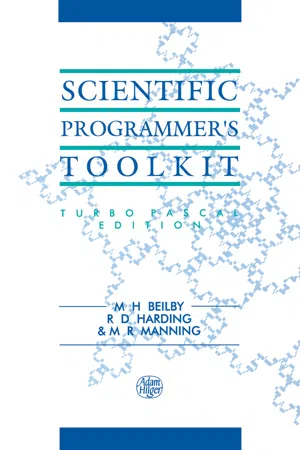
- English
- ePUB (mobile friendly)
- Available on iOS & Android
About This Book
The Scientific Programmer's Toolkit: Turbo Pascal Edition presents a complete software environment for anyone writing programs in mathematical, engineering, or science areas. This toolkit package is designed for use with Turbo Pascal, the de facto standard Pascal system for PC and compatible machines. The book and its software provides an integrated software library of programming tools. The programs and routines fall into three categories: graphical, mathematical, and utilities. Routines are further subdivided into three levels that reflect the experience of the user. For graphics and text handling routines there is also a Level 0, which provides an interface to the machine operating system. By using hierarchically structured routines, the clearly written text, and a wide range of example programs, software users can construct a user-friendly interface with minimal effort. The levels structure makes it easy for newcomers to use the Toolkit, and with growing experience, users can achieve more elaborate effects.The Scientific Programmer's Toolkit will be useful to consultants, researchers, and students in any quantitative profession or science, in private or public sector research establishments, or in secondary and higher education.
Frequently asked questions
Information
Chapter 1 Introducing the Toolkit
1.1 Preliminary
1.2 Toolkit levels
- Level 3 consists of the ready-to-run programs. You do not need any computer experience to use these, and can run them on any PC-compatible system, regardless of whether or not Pascal is available.
- Level 2 consists of Pascal units. These contain code to solve mathematical problems; to draw a variety of graphs; and to display ‘windows’ on the screen. They are designed to be quick and easy to use. For example, the Level 2 procedure draw_curve2 draws a graph of f(x) against x, given only f, and a few other parameters.
- Level 1 consists, again, of Pascal units. These contain more basic code, which, although more flexible than the Level 2, requires more effort to use. For example, the Level 1 graphics routines allow you to draw far more general graphs (for example, in non-orthogonal coordinate systems). However, they cannot plot a function; you have to use much more basic facilities which can only draw straight lines.
- Level 0 consists of the Pascal units used internally by the Toolkit itself; although these contain useful code (such as a tan function), they are always used in conjunction with the other levels.
1.2.1 Level 3
1.2.2 Level 2
- Code for numerical mathematics is to be found in the units Cit_math and Cit_matr, which are fully described in Chapters 4 and 5, respectively.
- Cit_math provides a number of routines for scalar mathematics. These find the zeroes and minima of functions; fit splines to curves; evaluate integrals (with several different methods available); solve ordinary differential equations (again, with a choice of method); and calculate fast Fourier transforms.
- Cit_matr contains code for matrix mathematics. This includes the solution of linear equations; decomposition and inversion of matrices; and the evaluation of matrix eigenvalues and eigenvectors. Once again, a choice of methods is provided for most of these operations.
- The graphics routines are to be found in the unit Cit_draw, which is fully described in Chapter 3.
- Cit_draw contains routines to plot functions or data values in two and three dimensions; draw contours and surfaces; and sample function values in one, two or three dimensions.
- The code for windowing is divided between four units: Cit_ctrl, Cit_disp, Cit_edit and Cit_menu. These units provide a convenient set of default windows, and facilities to display, modify, and input values within them. A full description of these units is given in Chapter 6.
- Cit_ctrl contains code for program control in a windowing environment. It declares a convenient set of default windows; displays error messages and help information; and provides the ‘option menus’ from which the user can make a choice.
- Cit_disp contains routines which display numbers and text within a window, with full control over the format of the output.
- Cit_edit contains code which either inputs or edits values within windows. These values may be numbers, strings, or expressions.
- Cit_menu provides a ‘menu’ facility, from which the user can select a number of options. The help facilities in Cit_ctrl can be called automatically if required.
1.2.3 Level 1
- Cit_eval contains code which evaluates an arbitrary expression, held in a string, and returns its value.
- Cit_form contains routines which display a floating-point value as a string in a number of styles; they provide a wider selection of formats than the Pascal procedure Write.
- Cit_grap contains the lower-level graphics routines; these draw lines, axes and polygons, and convert between user and screen graphics coordinates.
- Cit_text contains routines for handling strings of arbitrary length; a Pascal string variable has a fairly small upper bound to the number of characters it can hold.
- Cit_wind contains the lower-level windowing routines; these define, save and reload windows, ...
Table of contents
- Cover Page
- Half Title Page
- Title Page
- Copyright Page
- Contents
- Acknowledgements
- Guide to installing the software
- Guide to running the software
- Introduction
- Chapter 1 Introducing the Toolkit
- Chapter 2 Level 3 Programs
- Chapter 3 Graphics Routines
- Chapter 4 Mathematical Routines I
- Chapter 5 Mathematical Routines II
- Chapter 6 Windows and Menus
- Chapter 7 Graphics Routines
- Chapter 8 Screen and Text Utilities
- Chapter 9 Formatting Values and Evaluating Expressions
- Appendix 1 Unit Cit_core
- Appendix 2 Unit Cit_prim
- Appendix 3 Table of Error Messages
- Index